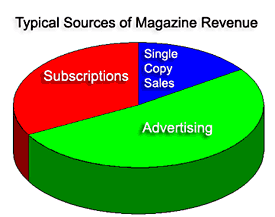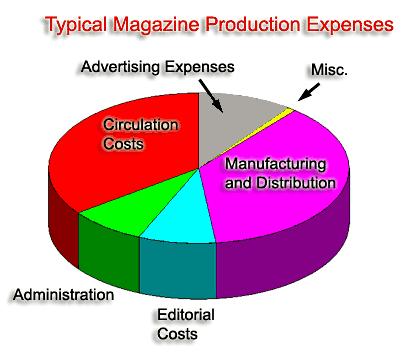Print Media 11 |
|
Magazines Part III Economics
As shown in the green area of the graph below, typical magazines derive at least half of their income from advertising. The magazine publishing business is highly competitive, largely because there is an ever growing number of media options available to advertisers. Ad revenue for most magazines has been dropping. This makes even mainstream magazines vulnerable to some degree of control by advertising interests. We noted in the last module that some trade publications are little more than public relations vehicles for their advertisers. Magazines tend to shy away from controversial content that can turn off advertisers. Advertisers have been known to send very clear messages about this. A while back a large American auto manufacturer sent a memo to about 50 magazines asking that their ad agency be notified if future issues of the magazine contained articles that addressed political, sexual, or social issues that might be seen as provocative, controversial, or offensive. The lead-time requested for this notification made it clear that the company wanted to be able to cancel ads in any issue that contained content they didn't like. The result, of course, would be the loss of tens of thousands--possibly even hundreds of thousands--of dollars in revenue. An editor who didn't cave in to these veiled threats might have a hard time explaining the resultant financial loss to a board of directors. In an even more blatant attempt to influence magazine content another large corporation informed a number of magazine publishers that the content of their magazines would be carefully monitored for several months, and that a large advertising contract would be awarded to the publication that portrayed their industry in the most favorable light. Not only is this a form of bribery, but it's also an affront to the free speech that's essential to an informed public. At the same time, this type of influence over content can have a negative impact on a magazine's success. For one thing, it could turn the magazine into a bland publication that could never tackle important, controversial topics. Even without clear threats from advertisers, magazine publishers, editors, and writers may quietly institute a form of "self censorship" and simply develop the habit of avoiding articles that might offend any major advertiser. Of course, it's difficult for magazine readers to know what articles a magazine is not publishing. But it is known that some magazines shy away from stories about the hazards of smoking out of fear of losing ad revenue from cigarette manufacturers, or shy away from articles on auto safety problems, out of fear of losing ad revenue from their many auto ads. The same applies to articles that might negatively affect drug companies--another big source of advertising. A few magazines do not accept advertising--Consumer Reports and Mad Magazine are notable examples. In the case of Consumer Reports, the magazine simply does not want their product evaluations influenced--or even give the appearance of being influenced--by an advertiser. Mad magazine seems to take pride in offending almost everyone, and it's doubtful that PR sensitive advertisers would even consider this magazine. However, surviving without advertising is difficult. Originally, Reader's Digest didn't carry advertising. However, faced the issue of raising the cost of subscriptions or accepting advertising, the decision was made to open the door to advertising. This graph shows a typical breakdown of magazine expenses. Note that the expenses for generating the magazine's content (administration and editorial) represent only a small part of total expenses. The advertising category consists of expenses involved in promoting the magazine. Not shown are "profits," which vary widely, and often constitute only about 2% of the revenue dollar.
Most of the larger magazines have editions that are tailored to specific geographic areas. Since some products or services are only available in certain areas, advertisers can target their ads to these regions and not have to pay for coverage they don't need. Today's electronic publishing techniques facilitate this process. Pages are composed on computer screens and sent via satellites, fiber optics, and even the Internet to printing facilities throughout the country and even the world. And speaking of the Internet, we also need to mention...
Since so much of the expense of producing a magazine is related to paper, postage, and circulation costs, magazine publishers have been following the development of the Internet as an alternative distribution method. Not only could magazine publishers save more than half of their operating costs by electronic publishing, but they would be able to deliver much more timely content. However, to date most of the experiments with subscription-based Internet magazines have not been successful. Internet users are simply not in the habit of paying for content. But there are exceptions. For example, there are the specialized services, such as financial web sites, that for a price hold the promise of offering competitive advantages by providing expert advice. Slate, These publications, and on-line publications such as These issues haven't discouraged publishers from developing an on-line presence. The Internet is just too important to overlook. Consequently, almost 20,000 magazines and journals can now be found on line--far more than exist in "hard copy" form. Traditional magazine and newspaper publishers face a dilemma. If they put their content on the Internet for free, will it impact their paid subscriptions? Or will the Internet site generate interest in the publication and result in more subscriptions? An even bigger question, is whether on-line advertising will eventually be able to cover on-line publications costs and free traditional magazines from ever-rising production costs before these costs make magazines prohibitively expensive. To date these questions have no definitive answers.
Magazine employees work in five divisions:
Like other forms of mass media, magazine publishing has seen a shift away from the independently owned publication houses of earlier decades to ownership by large media conglomerates. We discussed the implications of this in an earlier module There are many similarities between careers and career outlooks in the newspaper and magazine fields. Both are competitive, with the greatest competition in the editorial and writing divisions. Except for the top management positions, salaries are generally the highest in advertising and sales. Even so, starting salaries are typically below those of other professions. Many large corporations have their own publishing divisions. Although some of their publications are aimed at consumers, most are designed for employees or buyers. Training manuals are an important focus. Although working for a popular magazine may carry a certain amount of glamour, working in the publication division for a major corporation may provide a higher salary, more job security, and greater benefits. Unless a prospective employee has had significant experience in the field, a college degree is a prerequisite for employment, especially in the editorial and administration divisions. People who work in administration often hold Master's Degrees. The editorial division requires proficiency with computers, including familiarity with page layout and composition programs such as PageMaker and Quark Express.
If there is any truly bright spot in the magazine and newspaper publishing business it's in the non-English publications--primarily the Spanish publications. Not only have many of these publications been experiencing rapid growth, but they have been able to tackle important social issues. An example is the publication Exito! (The importance of the Spanish media is underlined by the fact that the most widely-viewed TV newscasts in Los Angeles and Miami are in Spanish.) In the next section we'll conclude the present mass media modules and look at the latest figures on magazine popularity along with some links to popular magazine web sites. |
|
To next module To
index © 1996 - 2005, All Rights Reserved.
|


 Manufacturing and distribution includes paper and postage, two expense categories that have been rapidly increasing.
Manufacturing and distribution includes paper and postage, two expense categories that have been rapidly increasing.